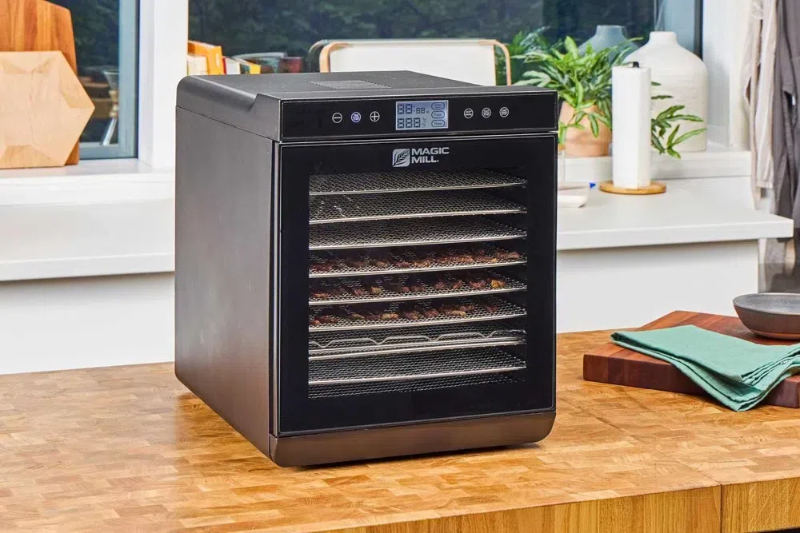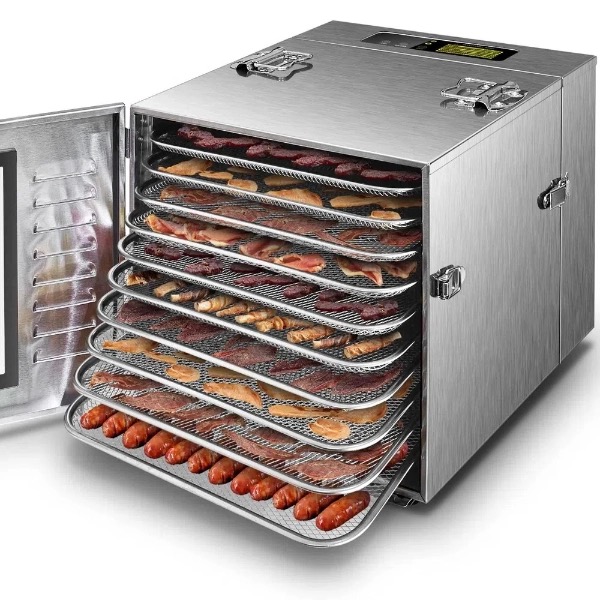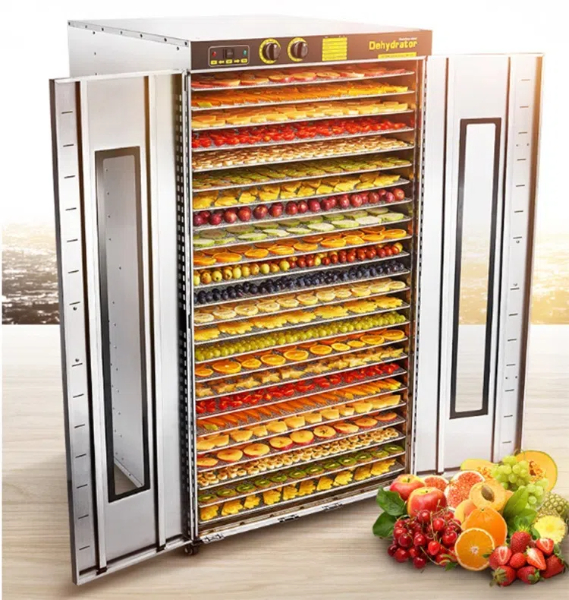
Content Menu
● Introduction
● What is a Cabinet Type Dehydrator?
● Benefits of Using Cabinet Type Dehydrators
>> High Efficiency
>> Large Capacity
>> Precise Temperature Control
>> Food Safety
>> Extended Shelf Life
>> Nutrient Preservation
>> Space-Saving Solutions
>> Versatility
>> Integrated Design
>> Portability
● Ideal Uses for Cabinet Type Dehydrators in Small Businesses
>> Dried Fruits and Vegetables
>> Meat Jerky and Fish
>> Herbs and Spices
>> Fruit Leather
>> Pet Treats
>> Floral and Craft Items
● Advanced Techniques for Using Cabinet Type Dehydrators
>> Pre-Treatment of Foods
>> Optimizing Airflow
>> Utilizing Humidity Control
>> Monitoring Moisture Content
>> Packaging and Storage
● Common Mistakes to Avoid
>> Overcrowding the Trays
>> Setting the Temperature Too High
>> Not Rotating the Trays
>> Storing Dehydrated Foods Improperly
● Case Studies: Small Businesses Using Cabinet Dehydrators
>> Case Study 1: Gourmet Snack Company
>> Case Study 2: Local Herb Farm
>> Case Study 3: Pet Treat Business
● Conclusion
● FAQ
>> 1. What are the main advantages of using a cabinet type dehydrator over other types of dehydrators?
>> 2. What types of food can be dehydrated using a cabinet type dehydrator?
>> 3. How do I ensure that the food is dried evenly in a cabinet type dehydrator?
>> 4. What is the ideal temperature for dehydrating different types of food?
>> 5. How long does it take to dehydrate food in a cabinet type dehydrator?
● Citations:
Introduction
For small businesses in the food industry, finding efficient and cost-effective methods for preserving food is crucial. Cabinet type dehydrators offer an ideal solution, providing a blend of versatility, capacity, and precision. These machines are designed to remove moisture from food products, significantly extending their shelf life while preserving natural flavors, colors, and essential nutrients. Unlike simpler dehydrators, cabinet models offer unparalleled consistency and control, making them a preferred choice for commercial applications and serious home users.

What is a Cabinet Type Dehydrator?
A cabinet type dehydrator, also known as a box-type or shelf-style dehydrator, is a self-contained unit meticulously engineered to eliminate moisture from food products. These dehydrators feature a fully enclosed cabinet with trays that slide in and out, similar to an oven. The heating element and fan are typically located at the back of the cabinet, ensuring even heat distribution throughout the interior.
Benefits of Using Cabinet Type Dehydrators
High Efficiency
Cabinet dehydrators offer efficient and consistent dehydration for a wide range of fresh products, ensuring minimal energy waste. This efficiency translates to lower operating costs and a more sustainable approach to food preservation. This is achieved through optimized airflow and advanced temperature regulation, which minimizes energy consumption while maintaining consistent drying conditions.
Large Capacity
Cabinet dehydrators can hold numerous trays, allowing you to dehydrate large batches of food simultaneously. This is particularly beneficial for commercial operations that need to process significant quantities of ingredients quickly. Large capacity means less time spent running multiple batches and more efficiency in production. This is especially important for businesses that operate on tight schedules and need to maximize their throughput.
Precise Temperature Control
Cabinet dehydrators typically come with sophisticated temperature control systems that allow you to set and maintain the ideal temperature for different types of food. This ensures that the food is dried evenly and thoroughly without overheating or scorching. Precision is critical to preserving the flavor and nutritional value of your products. Digital controls and sensors constantly monitor and adjust the internal temperature to maintain optimal drying conditions.
Food Safety
Cabinet dehydrators help ensure food safety by removing moisture, which inhibits the growth of bacteria, mold, and other microorganisms. Consistent drying conditions in a cabinet dehydrator ensure that all food items are dehydrated to a safe moisture level. Regular cleaning and maintenance are also crucial for maintaining food safety standards.

Extended Shelf Life
One of the most significant benefits of using a cabinet dehydrator is the extended shelf life it provides for food products. Dehydrated foods can last for months or even years without spoiling, making them ideal for long-term storage and distribution. This is particularly important for seasonal produce or for businesses that want to reduce waste. Proper packaging and storage techniques can further extend the shelf life of dehydrated products.
Nutrient Preservation
Cabinet dehydrators excel at preserving the natural flavors, colors, and nutrients in food. The controlled drying process minimizes degradation, ensuring that the dehydrated products retain their nutritional value. This is achieved through precise temperature control and even airflow, which prevents overheating and preserves essential vitamins and minerals. Low-temperature dehydration is a technique often used to further enhance nutrient retention.
Space-Saving Solutions
Despite their high capacity, cabinet dehydrators provide space-saving solutions. Their vertical design maximizes the use of floor space, making them suitable for facilities with limited room. This is essential for smaller businesses or those who need to optimize their workspace. The compact footprint allows businesses to integrate these dehydrators into existing production lines without significant modifications.
Versatility
Can be used for various types of food products, from fruits and vegetables to meats and herbs. The dehydrator's adjustable temperature settings and customizable tray configurations allow businesses to process a diverse range of ingredients with ease.
Integrated Design
The seamless integration of the heat pump dryer with the chamber is a hallmark of cabinet dehydrators. This design optimizes performance and energy utilization, ensuring that the machine operates at peak efficiency. The integrated system minimizes heat loss and maximizes airflow, resulting in faster and more consistent drying times.
Portability
Thoughtfully designed for easy loading into standard shipping containers, cabinet dehydrators can be quickly transported and immediately put into operation upon receipt. This portability is a significant advantage for businesses that need to move or expand their operations. The robust construction ensures that the dehydrator can withstand the rigors of transportation without damage.
Ideal Uses for Cabinet Type Dehydrators in Small Businesses
Dried Fruits and Vegetables
One of the most common uses for cabinet dehydrators is drying fruits and vegetables. Small businesses can use these dehydrators to create a variety of healthy snacks, ingredients, and garnishes.
- Examples: Apple slices, banana chips, dried berries, tomato halves, vegetable chips.
- Business Applications: Creating gourmet snack mixes, producing dried fruit for baking, making vegetable chips for healthy snack options.
Meat Jerky and Fish
Cabinet dehydrators are also excellent for making meat jerky and dried fish products. The precise temperature control ensures that the meat is dried safely and evenly, resulting in a high-quality product with a long shelf life.
- Examples: Beef jerky, turkey jerky, fish snacks.
- Business Applications: Developing unique jerky flavors, offering premium dried fish snacks, creating protein-rich snacks for athletes.
Herbs and Spices
Small businesses can use cabinet dehydrators to dry fresh herbs and spices, preserving their flavor and aroma for extended periods. This is particularly useful for businesses that grow their own herbs or source them locally.
- Examples: Basil, rosemary, thyme, oregano, chili peppers.
- Business Applications: Creating custom spice blends, producing dried herbs for cooking, making artisanal spice rubs.
Fruit Leather
Fruit leather is a healthy and delicious snack that can be easily made using a cabinet dehydrator. Small businesses can create a variety of flavors and combinations, offering customers a unique and nutritious product.
- Examples: Mango fruit leather, strawberry fruit leather, mixed berry fruit leather.
- Business Applications: Offering a variety of fruit leather flavors, creating fruit leather snack packs, developing customized fruit leather recipes.
Pet Treats
With the rising demand for natural and healthy pet treats, small businesses can capitalize on this market by using cabinet dehydrators to make homemade pet treats. These treats can be made from a variety of ingredients, ensuring that they are free from artificial additives and preservatives.
- Examples: Sweet potato chews, chicken jerky, fish skins.
- Business Applications: Developing a line of natural pet treats, offering customized pet treat recipes, creating healthy snack options for pets.
Floral and Craft Items
In addition to food-related applications, cabinet dehydrators can also be used to dry flowers and other craft items. This opens up opportunities for small businesses in the floral and craft industries.
- Examples: Dried flower arrangements, potpourri, dried herbs for crafts.
- Business Applications: Creating dried flower bouquets, producing potpourri blends, making dried herb decorations.
Advanced Techniques for Using Cabinet Type Dehydrators
Pre-Treatment of Foods
Pre-treating foods before dehydration can significantly enhance the quality and appearance of the final product. Blanching vegetables, for example, helps to preserve their color and prevent enzymatic browning. Similarly, marinating meats before drying can infuse them with flavor and tenderize them.
Optimizing Airflow
Proper airflow is essential for even and efficient dehydration. Ensure that the dehydrator trays are not overcrowded and that there is sufficient space between the food items for air to circulate. Rotating the trays periodically can also help to promote even drying.
Utilizing Humidity Control
Some cabinet dehydrators come equipped with humidity control features that allow you to adjust the moisture levels inside the dehydrator. This can be particularly useful for drying delicate items or for achieving specific textures in the final product.
Monitoring Moisture Content
Regularly monitoring the moisture content of the food items during dehydration is crucial for ensuring that they are dried to the desired level. Use a food thermometer to check the internal temperature and a moisture meter to measure the moisture content.
Packaging and Storage
Proper packaging and storage are essential for preserving the quality and extending the shelf life of dehydrated foods. Use airtight containers or vacuum-sealed bags to protect the food from moisture and air. Store the dehydrated foods in a cool, dark, and dry place.
Common Mistakes to Avoid
Overcrowding the Trays
Overcrowding the dehydrator trays restricts airflow and can result in uneven drying. Make sure to leave enough space between the food items for air to circulate freely.
Setting the Temperature Too High
Setting the temperature too high can cause the food to dry unevenly, resulting in a hard outer layer and a moist interior. Start with a lower temperature and gradually increase it as needed.
Not Rotating the Trays
Not rotating the trays can lead to uneven drying, as the food items at the top and bottom of the dehydrator may dry at different rates. Rotate the trays periodically to ensure that all the food items dry evenly.
Storing Dehydrated Foods Improperly
Storing dehydrated foods in improper conditions can cause them to reabsorb moisture and spoil. Always store dehydrated foods in airtight containers or vacuum-sealed bags in a cool, dark, and dry place.
Case Studies: Small Businesses Using Cabinet Dehydrators
Case Study 1: Gourmet Snack Company
A small gourmet snack company uses a cabinet dehydrator to create a line of premium dried fruit and vegetable snacks. By using precise temperature control and high-quality ingredients, they have been able to create unique and delicious snacks that appeal to health-conscious consumers.
Case Study 2: Local Herb Farm
A local herb farm uses a cabinet dehydrator to dry their herbs and spices for sale at local farmers' markets. The dehydrator allows them to preserve their harvest and offer a wide variety of dried herbs and spices to their customers year-round.
Case Study 3: Pet Treat Business
A small pet treat business uses a cabinet dehydrator to make natural and healthy pet treats. By using high-quality ingredients and avoiding artificial additives and preservatives, they have been able to create treats that are both nutritious and delicious for pets.
Conclusion
Cabinet type dehydrators offer a versatile and efficient solution for small businesses looking to preserve food and create a variety of value-added products. Their high capacity, precise temperature control, and consistent drying performance make them an ideal choice for commercial applications. By investing in a high-quality cabinet dehydrator, small businesses can extend the shelf life of their products, reduce waste, and offer customers healthy and delicious snacks, ingredients, and treats. With proper techniques and maintenance, these dehydrators can be a valuable asset for any small business in the food industry.

FAQ
1. What are the main advantages of using a cabinet type dehydrator over other types of dehydrators?
Cabinet type dehydrators offer greater capacity, precision, and efficiency compared to stackable models. They provide more consistent drying results and are ideal for commercial applications and serious home users who demand the best possible results.
2. What types of food can be dehydrated using a cabinet type dehydrator?
Cabinet type dehydrators can be used for various types of food products, including fruits, vegetables, meats, herbs, and spices. They are versatile tools for creating dried snacks, ingredients, and treats.
3. How do I ensure that the food is dried evenly in a cabinet type dehydrator?
To ensure even drying, make sure to arrange the food items in a single layer on the dehydrator trays, leaving enough space between them for air circulation. Also, check that the dehydrator's fan and heating element are functioning properly to provide consistent heat distribution.
4. What is the ideal temperature for dehydrating different types of food?
The ideal temperature for dehydrating food varies depending on the type of food. Generally, fruits and vegetables are dehydrated at lower temperatures (130-140°F), while meats and fish require higher temperatures (145-155°F) to ensure food safety. Always consult a reliable dehydration guide or recipe for specific temperature recommendations.
5. How long does it take to dehydrate food in a cabinet type dehydrator?
The drying time depends on the type of food, the thickness of the slices, and the dehydrator's temperature and airflow. It can take anywhere from a few hours to over 24 hours to fully dehydrate food. Check the food regularly and remove it when it is dry and leathery.
Citations:
[1] https://www.dryeratech.com/the-ultimate-guide-to-cabinet-type-dehydrator-machines.html
[2] https://patents.google.com/patent/CN201919616U/zh
[3] https://www.dryeratech.com/the-best-cabinet-type-dehydrators-on-the-market-in-2025.html
[4] https://patents.google.com/patent/CN110207480A/zh
[5] http://www.dryer.comcastbiz.net/dehydrators/cabinet_dryers.html
[6] https://patents.google.com/patent/CN1110593C/zh
[7] https://www.foodandwine.com/lifestyle/kitchen/best-food-dehydrators
[8] https://patents.google.com/patent/CN109252340A/zh











